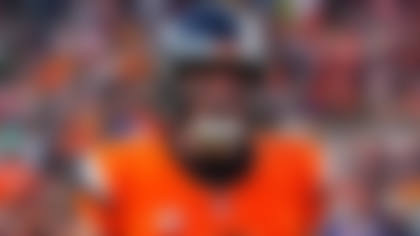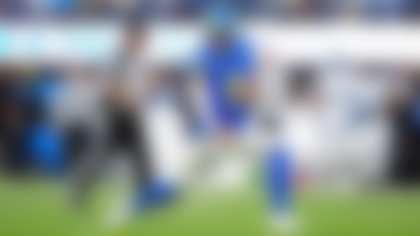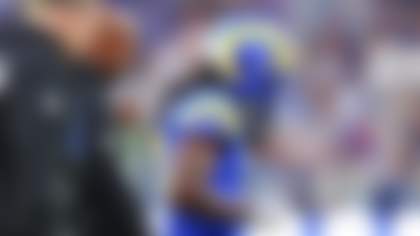Released by Cleveland early this week, veteran quarterback Josh McCown still cares enough to heartily endorse Patriots trade candidateJimmy Garoppolo as the ideal solution to the Browns' long-standing quarterback woes.
If the Browns have designs on offering the No. 12 overall pick in the 2017 NFL Draft to coax Bill Belichick into parting with his valuable Tom Brady insurance, they might just discover that equally desperate franchises such as the 49ers and Bears are willing to up the ante.
While Tony Romo threatens to dominate the bandwidth and airwaves for the next month leading up to the trade deadline, Garoppolo will be the more sought-after commodity.
Romo vs. Garoppolo
Even if the Cowboys have made it their No. 1 offseason priority, a Romo trade is complex, with moving parts in every direction.
Turning 37 in April -- and just two seasons removed from a serious run at MVP honors -- Romo will limit his market to Super Bowl contenders. The Broncos are reportedly willing to await Romo's release, the Cardinals just received a renewed commitment from Carson Palmer, the Texans have Brock Osweiler's contract millstone hanging around their proverbial neck and Alex Smith has four years invested in Andy Reid's Chiefs offense.
Further complicating matters: the forbidding cap hit the Cowboys will be forced to swallow, Romo's likely request for a new contract and major durability concerns for an increasingly brittle quarterback.
If Romo's ceiling is the fourth consecutive quarterback age 37 or older to walk away with the Lombardi Trophy, his floor is falling prey to a career-ending hit before he gives his new team a worthwhile return on its investment.
A Garoppolo trade, on the other hand, is relatively simple. Armed with the knowledge that the 2014 second-round pick's rookie contract is set to expire after the 2017 season, the Patriots understand this is their window to extract maximum value for Garoppolo while promoting the promising Jacoby Brissett to Brady's understudy.
Belichick has the luxury of holstering both young quarterbacks for insurances purposes until he fields multiple trade offers he can play against each other.
Perfect storm for Patriots windfall
Falcons general manager Thomas Dimitroff once remarked, "Until you find your quarterback, the search for him consumes you."
Just this week, NFL Network draft analyst Mike Mayock emphasized that he would be "scared to death" to invest an early first-round pick in Clemson's Deshaun Watson, North Carolina's Mitch Trubisky or Notre Dame's DeShone Kizer.
After watching Jared Gofffaceplant and Carson Wentzbattle major mechanical issues as rookies, NFL teams were served a useful reminder that the transition from college to pro ball is often fraught with immediate growing pains.
Young quarterbacks cost jobs; proven quarterbacks create opportunities.
How can a rebuilding organization pull off an extreme makeover when the proven signal-callers on the market are an aging injury risk (Romo), a coach-killing tease (Jay Cutler) and a purgatorial dice roll (Tyrod Taylor)?
The solution is to pay a premium price for an early-round talent incubated under the watchful eye of Belichick, Brady and quarterback guru Josh McDaniels.
The Browns are lousy with draft picks and cap space. Their offense is now run by one of football's most fertile minds. What they don't have is a face of the franchise under center.
The 49ers boast $80 million in cap space, extra picks in each of the final four rounds of the draft and a new head coach with a Midas quarterback touch.
Bears general manager Ryan Pace, a graduate of Garoppolo's Eastern Illinois, is sitting on the draft's No. 3 overall pick -- and a mandate to find Cutler's replacement.
When Hue Jackson, Kyle Shanahan and Pace pore over the game film, they're going to fall in love with Garoppolo.
In his first career start, Garoppolo went on the road in a nationally televised season opener and mowed down a consensus Super Bowl contender without the services of the NFL's premier tight end. Two quarters into his second career start, Garoppolo was the best player on field before a shoulder injury knocked him out of the game.
In that sense, it actually works to New England's benefit that Garoppolo has just six quarters as a starter to over-analyze. If there are warts, defenses had yet to expose them.
Is Garoppolo worth the price?
I know what you're thinking. Look at the bind Houston is in after overpaying for a similarly inexperienced quarterback. Osweiler turned into a pumpkin once the clock struck midnight on his alleged $72 million contract.
Putting the obvious talent differential aside, Garoppolo's contract status works as a point in his favor.
His new team will have benefit of his services for 16 games at less than $1 million in 2017. In the worst-case scenario that he's exposed as a bust -- just a product of the Patriots' system -- there's no Osweiler-like financial albatross precluding another quarterback investment in 2018. In the best-case scenario that he emerges as a legitimate face of the franchise, his new team will happily pay the going rate for an established quarterback.
Even if there's no clear answer due to injury or inconsistent results, the franchise tag is available for a sequel season in 2018.
Now that we've cleared the contract hurdle, let's examine the risk. Garoppolo has started just two NFL games and thrown fewer than 100 passes in three seasons. Isn't it irresponsible to part with a first-round pick -- or more -- without a greater sample size?
How does that qualify as more risky than surrendering two first-round picks, two second-round picks and two third-round picks as the Rams did for the opportunity to gamble on a quarterback with zero starts and zero attempts?
Teams have no qualms about overpaying for unproven college prospects. It doesn't matter how the solution is found. Sustained NFL success correlates to steady quarterback performance whereas exhaustive searches for a solution to professional sports' most valuable position deplete resources otherwise spent stockpiling talent.
Acknowledging that the value of a legitimate young franchise quarterback is beyond calculable, how can Jackson, Shanahan and Pace be so sure that Garoppolo fits that description? Is there reason to believe he's a better bet for post-New England success than former Brady backups such as Matt Cassel, Brian Hoyer and Ryan Mallett?
The answer is a resounding yes.
When Shanahan was running the Browns offense in 2014, he ranked Garoppolo just behind Derek Carr as the second-best prospect in the draft.
"He was a very good thrower," Shanahan said last week, via the Plain Dealer. "Tough guy, kept his eyes down the field, could get rid of the ball fast. Really liked the person. ... I really thought he was a very intelligent, tough player with a good throwing motion."
That scouting report jibes with the game film from Garoppolo's two NFL starts.
Against the Cardinals and Dolphins, Garoppolo showed impressive command of the offense, poise versus the blitz, a lightning-quick release, light feet to slide in the pocket and escape pressure, excellent ball placement on tight-window throws and the arm talent to change speed on his passes. Even better, he worked through his progressions, kept his eyes up, spread the ball around to all of his targets and even showed the subtle veteran move of looking off a safety on a touchdown throw to Martellus Bennett.
To be clear, Garoppolo is not a big, strapping pocket passer with a powerful downfield cannon. But that's hardly an issue at a time when even the league's rifle arms (Joe Flacco, Matthew Stafford) are playing in offenses that feature short, quick throws within 20 yards of the line of scrimmage.
When I watch Garoppolo, I see an accurate, athletic quarterback who shares traits with Romo and Marcus Mariota.
Cardinals coach Bruce Arians drew the same comparison with Romo last summer.
When he first scouted Garoppolo, Arians noted the similarities with fellow former Eastern Illinois star Romo.
"Both were similar sizes, arm strength, very accurate," Arians explained. "Both moved around good. Jimmy's an excellent athlete. A very accurate passer. ... You have to defend his legs as much as his arm."
The league has changed since the turn of the century, when journeymen quarterbacks such as Kurt Warner, Rich Gannon, Jeff Garcia and Doug Flutie came out of NFL Europe, Canada or the fringes of NFL rosters to pace the leaderboards.
A decade and a half later, NFL Europe is a ghost, the Canadian league is barren and spread offenses allow college quarterbacks to succeed without blue-chip talent. Desperate coaches and executives consumed by the search know full well that there's an exorbitant price tag for potential saviors.












